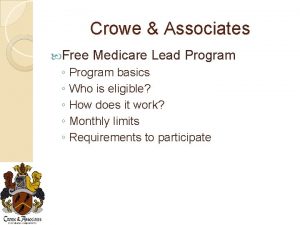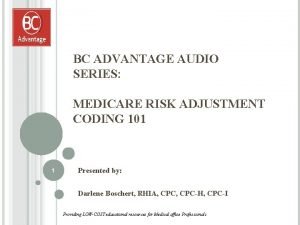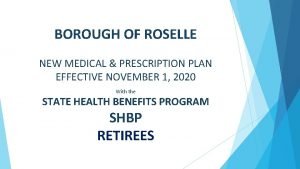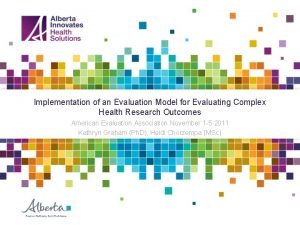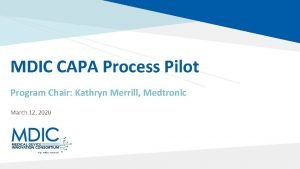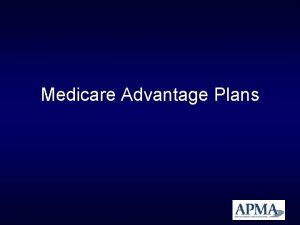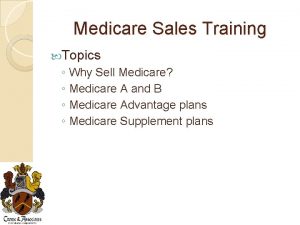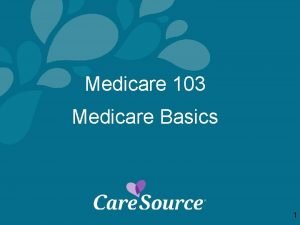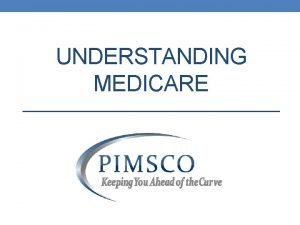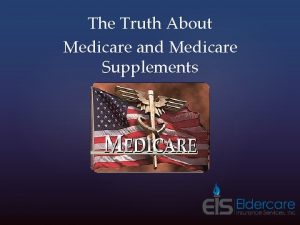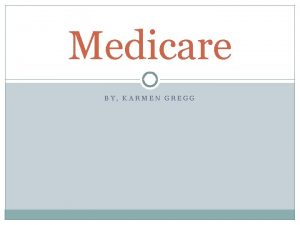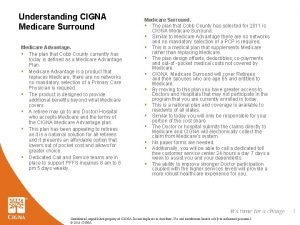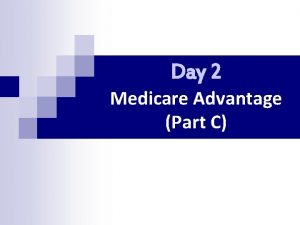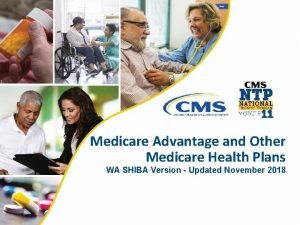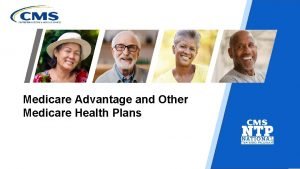Medicare Advantage 2020 July 21 2020 Kathryn A














- Slides: 14

Medicare Advantage 2020 July 21, 2020 Kathryn A. Coleman Center for Medicare Drug & Health Plan Contract Administration Group 1

2020 – A Year of Growth • Access to Medicare Advantage remains strong and stable • Enrollment is growing • Premiums continue to decrease • More benefits are available 2

Access Remains Strong 2019 2020 3

Enrollment Continues to Grow Note: July enrollment of the plan year is used for 2014 -2020. 4

CY 2020 MA Supplemental Benefits • Traditional Supplemental Benefits — Some of the most popular benefits based on enrollees, include vision (97%), hearing (89%), and dental (82%). • Reinterpretation of Uniformity (MA Uniformity Flexibility) — Additional benefits or reduced cost sharing tied to enrollees with one or more disease states. • Expanded Primarily Health Related Supplemental Benefits — Expanded definition of supplemental benefit considered to be “primarily health related. ” 5

Special Supplemental Benefits for the Chronically Ill (1 of 3) Beginning 2020 MA plans can offer Special Supplemental Benefits for the Chronically Ill for certain chronically ill enrollees. • MA plans can choose to only offer these benefits for one or more specific chronic condition • Reduced cost sharing for specific benefits (e. g. , lower copay for specialist or acupuncture) • Standard supplemental benefits offered only to the chronically ill enrollees (e. g. , therapeutic massage) • Non-health related supplemental benefits (e. g. , transportation for non-medical needs, food and produce)

Special Supplemental Benefits for the Chronically Ill (2 of 3) • A chronically ill enrollee is an individual who: • Has one or more comorbid and medically complex chronic conditions that is life threatening or significantly limits the overall health or function of the enrollee; • Has a high risk of hospitalization or other adverse health outcomes; and • Requires intensive care coordination • MA plans may offer a benefit to a chronically ill enrollee if it has a reasonable expectation of improving or maintaining their health or overall function 7

Special Supplemental Benefits for the Chronically Ill - CY 2020 (3 of 3) • Special Supplemental Benefits for the Chronically Ill (SSBCI) — Additional benefits or reduced cost sharing for certain chronically ill enrollees, including nonprimarily health related benefits. — 7% of enrollees have access to at least one SSBCI through 267 plans. — The most popular benefits are food/produce, pest control, and transportation for non-medical needs. 8

Expanded Benefit Offerings in Response to COVID 19 • CMS announced in mid-March 2020 that MA plans were allowed to make mid-year benefit enhancements. • Resulted from the unique circumstances related to outbreak of COVID-19 9

Medicare Advantage Networks • Network Adequacy standards and methodology for Medicare Advantage plans are now codified in regulation. (42 C. F. R. § 422. 116) • The regulation defines, among other things: • Provider and Facility Specialty Types Subject to Network Adequacy Reviews • County Type Designations & Ratios • Minimum Number of Providers • Time & Distance • Exceptions to Standards • Telehealth Credit • Certificate of Need Law Credit 10

D-SNP “Look Alikes” Promoting integrated care for people dually eligible for Medicare and Medicaid is a CMS Priority Phase out “D-SNP look-alikes” – plans that almost exclusively serve dually eligible individuals but are not currently special needs plans. • Beginning for 2022, no new plans (other than SNPs) that project that 80% or more of their enrollment is dually eligible • By 2023, all plans with 80%+ dually eligible enrollment will need to be SNPs • New mechanisms to minimize disruption for people currently enrolled in a D-SNP look-alike. 11

Special Election Period for Exceptional Conditions Established 2 new SEPs • SEP for Individuals Enrolled in a Plan Identified by CMS as a Consistent Poor Performer • SEP for Individuals Enrolled in a Plan Placed in Receivership SEP for Government Entity-Declared Disaster or Other Emergency • As of 1/1/21 replaces SEP for Individuals Affected by a FEMA-Declared Weather-Related Emergency or Major Disaster • Does not require FEMA declaration; not limited to weather-related events • Starts as of the date the declaration is made, the incident start date or, if different, the start date identified in the declaration, whichever is earlier • Ends 2 full calendar months following the end date identified in the declaration or, if different, the date the end of the incident is announced, whichever is later Resource Mailbox: https: //deepportal. lmi. org/deepmailbox/ 12

ESRD and Medicare Advantage • The CURES Act expanded enrollment options for individuals with end stage renal disease (ESRD). • Starting January 1, 2021, beneficiaries with ESRD will be able to enroll in any Medicare Advantage (MA) plan in their area. 13

Questions Contact: Kathryn. Coleman@cms. hhs. gov 14
 Medicare lead programs
Medicare lead programs Medicare advantage risk adjustment 101
Medicare advantage risk adjustment 101 Medicare sales certification and recertification
Medicare sales certification and recertification Sonj.aetnamedicare.com
Sonj.aetnamedicare.com Gcc july 2020
Gcc july 2020 Comparative advantage vs absolute advantage
Comparative advantage vs absolute advantage Actual mechanical advantage vs ideal mechanical advantage
Actual mechanical advantage vs ideal mechanical advantage Erin kathryn 2016
Erin kathryn 2016 Erin kathryn 2014
Erin kathryn 2014 Kathryn bigelow legs
Kathryn bigelow legs Erin kathryn 2017
Erin kathryn 2017 Drugačen knjiga
Drugačen knjiga Kathryn graham alberta innovates
Kathryn graham alberta innovates Capacoola
Capacoola Water quality act of 1965
Water quality act of 1965
